Finance Report: Bank Roles, Debt Finance, Basel III, and Crisis
VerifiedAdded on 2020/05/28
|7
|1631
|70
Report
AI Summary
This finance report critically examines the key roles of banks in contributing to a country's financial system, focusing on credit and liquidity provisions. It evaluates the problems associated with debt finance for financial deficit units and discusses the impact of Basel III regulations on capital adequacy, liquidity, and leverage. The report explains the process of asset securitization and its benefits for banks, while also analyzing the implications of the global financial crisis on bank performance and the measures taken by different countries to mitigate the crisis, including Singapore, the UK, and the USA, with specific examples from OCBC Bank, Barclays Bank, and Citigroup. The report uses financial data to support the analysis.
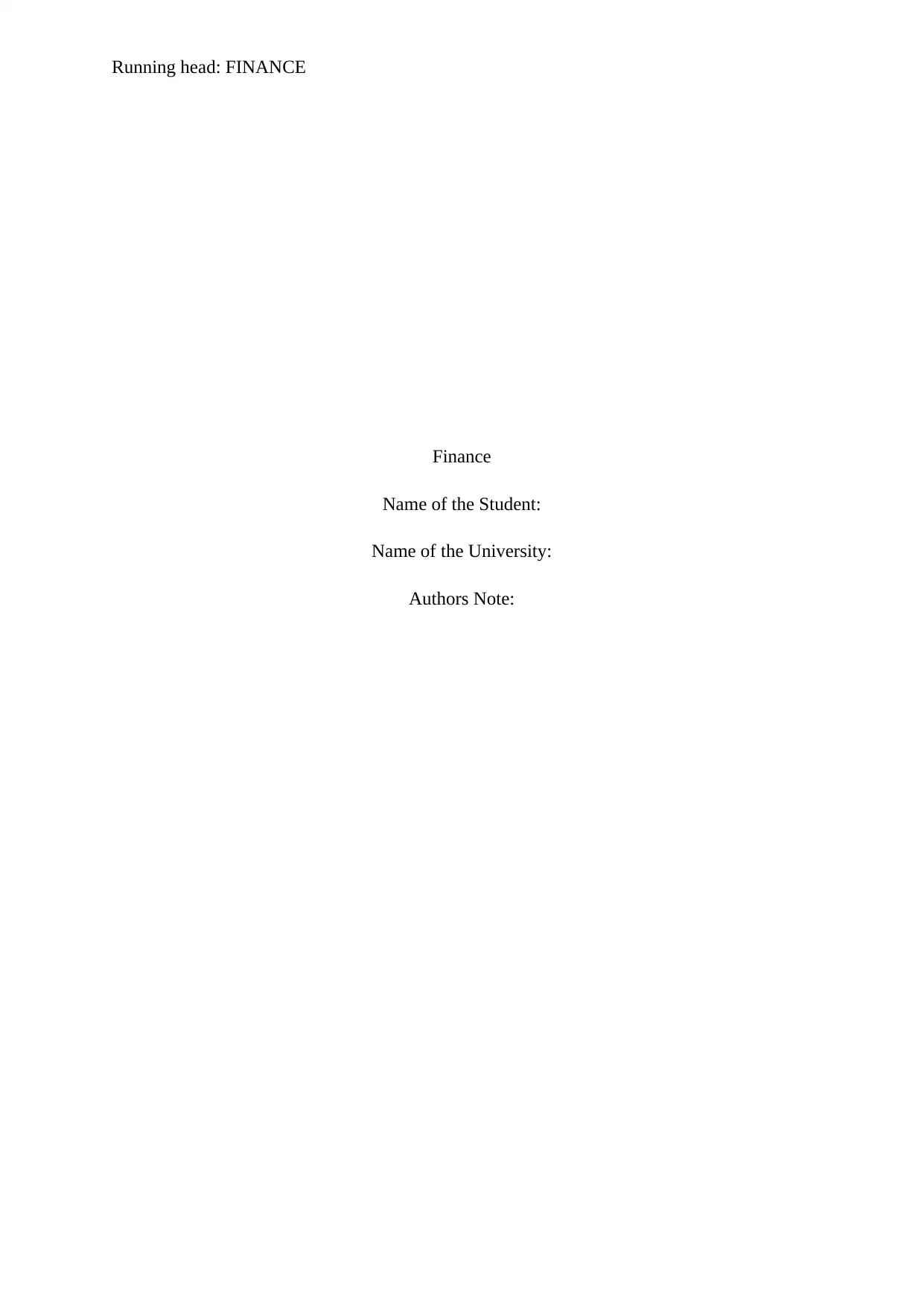
Running head: FINANCE
Finance
Name of the Student:
Name of the University:
Authors Note:
Finance
Name of the Student:
Name of the University:
Authors Note:
Paraphrase This Document
Need a fresh take? Get an instant paraphrase of this document with our AI Paraphraser
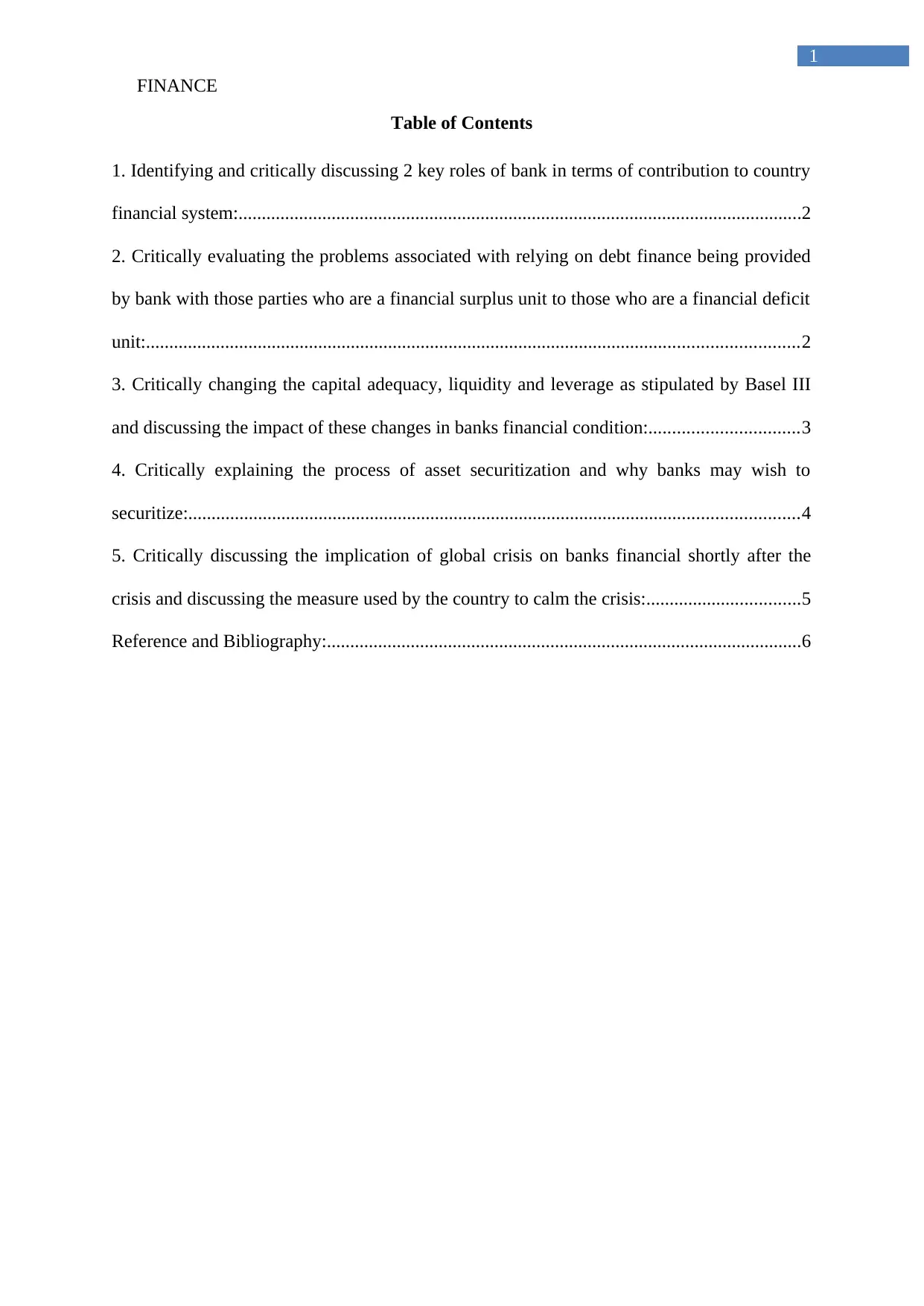
FINANCE
1
Table of Contents
1. Identifying and critically discussing 2 key roles of bank in terms of contribution to country
financial system:.........................................................................................................................2
2. Critically evaluating the problems associated with relying on debt finance being provided
by bank with those parties who are a financial surplus unit to those who are a financial deficit
unit:............................................................................................................................................2
3. Critically changing the capital adequacy, liquidity and leverage as stipulated by Basel III
and discussing the impact of these changes in banks financial condition:................................3
4. Critically explaining the process of asset securitization and why banks may wish to
securitize:...................................................................................................................................4
5. Critically discussing the implication of global crisis on banks financial shortly after the
crisis and discussing the measure used by the country to calm the crisis:.................................5
Reference and Bibliography:......................................................................................................6
1
Table of Contents
1. Identifying and critically discussing 2 key roles of bank in terms of contribution to country
financial system:.........................................................................................................................2
2. Critically evaluating the problems associated with relying on debt finance being provided
by bank with those parties who are a financial surplus unit to those who are a financial deficit
unit:............................................................................................................................................2
3. Critically changing the capital adequacy, liquidity and leverage as stipulated by Basel III
and discussing the impact of these changes in banks financial condition:................................3
4. Critically explaining the process of asset securitization and why banks may wish to
securitize:...................................................................................................................................4
5. Critically discussing the implication of global crisis on banks financial shortly after the
crisis and discussing the measure used by the country to calm the crisis:.................................5
Reference and Bibliography:......................................................................................................6
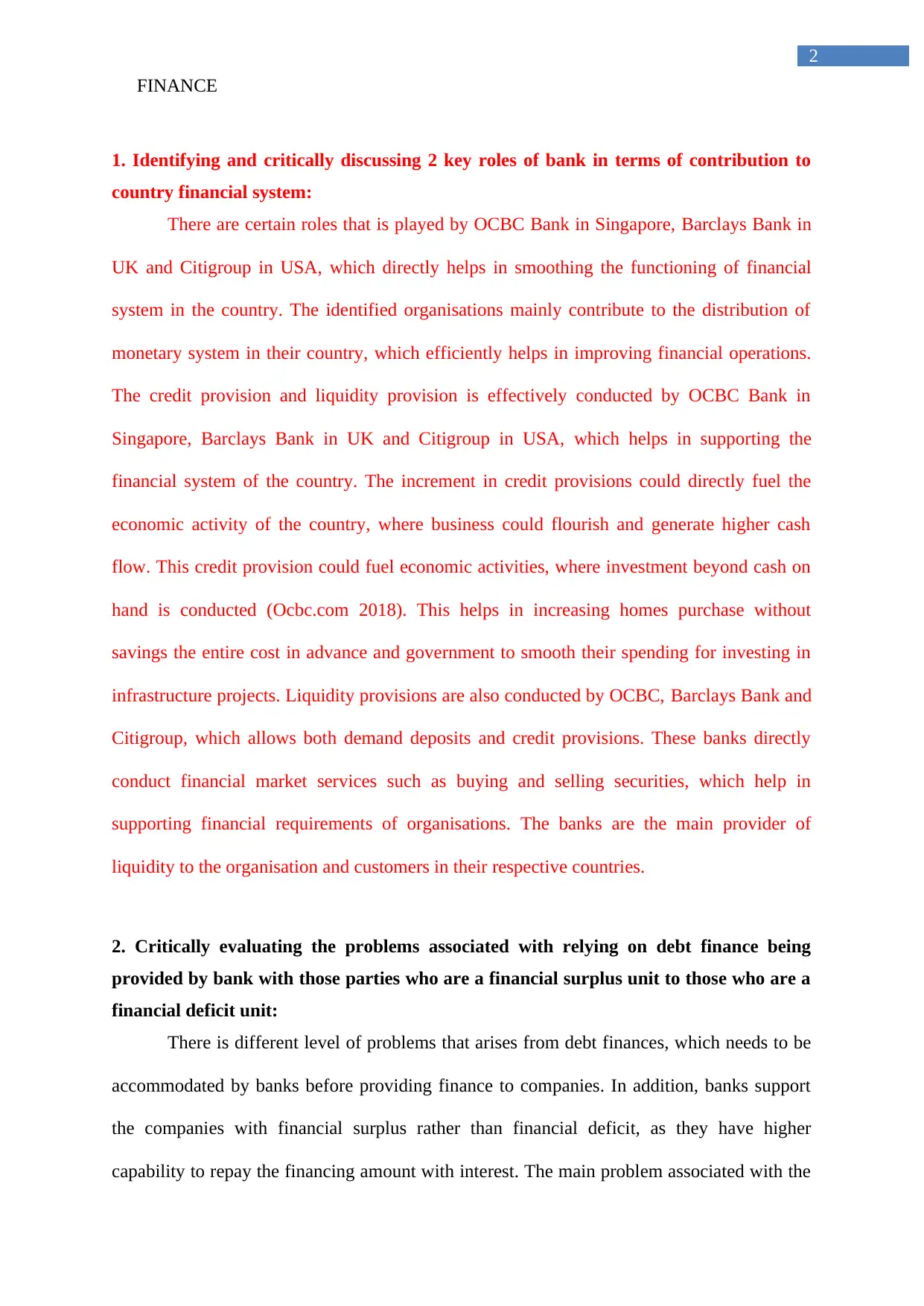
FINANCE
2
1. Identifying and critically discussing 2 key roles of bank in terms of contribution to
country financial system:
There are certain roles that is played by OCBC Bank in Singapore, Barclays Bank in
UK and Citigroup in USA, which directly helps in smoothing the functioning of financial
system in the country. The identified organisations mainly contribute to the distribution of
monetary system in their country, which efficiently helps in improving financial operations.
The credit provision and liquidity provision is effectively conducted by OCBC Bank in
Singapore, Barclays Bank in UK and Citigroup in USA, which helps in supporting the
financial system of the country. The increment in credit provisions could directly fuel the
economic activity of the country, where business could flourish and generate higher cash
flow. This credit provision could fuel economic activities, where investment beyond cash on
hand is conducted (Ocbc.com 2018). This helps in increasing homes purchase without
savings the entire cost in advance and government to smooth their spending for investing in
infrastructure projects. Liquidity provisions are also conducted by OCBC, Barclays Bank and
Citigroup, which allows both demand deposits and credit provisions. These banks directly
conduct financial market services such as buying and selling securities, which help in
supporting financial requirements of organisations. The banks are the main provider of
liquidity to the organisation and customers in their respective countries.
2. Critically evaluating the problems associated with relying on debt finance being
provided by bank with those parties who are a financial surplus unit to those who are a
financial deficit unit:
There is different level of problems that arises from debt finances, which needs to be
accommodated by banks before providing finance to companies. In addition, banks support
the companies with financial surplus rather than financial deficit, as they have higher
capability to repay the financing amount with interest. The main problem associated with the
2
1. Identifying and critically discussing 2 key roles of bank in terms of contribution to
country financial system:
There are certain roles that is played by OCBC Bank in Singapore, Barclays Bank in
UK and Citigroup in USA, which directly helps in smoothing the functioning of financial
system in the country. The identified organisations mainly contribute to the distribution of
monetary system in their country, which efficiently helps in improving financial operations.
The credit provision and liquidity provision is effectively conducted by OCBC Bank in
Singapore, Barclays Bank in UK and Citigroup in USA, which helps in supporting the
financial system of the country. The increment in credit provisions could directly fuel the
economic activity of the country, where business could flourish and generate higher cash
flow. This credit provision could fuel economic activities, where investment beyond cash on
hand is conducted (Ocbc.com 2018). This helps in increasing homes purchase without
savings the entire cost in advance and government to smooth their spending for investing in
infrastructure projects. Liquidity provisions are also conducted by OCBC, Barclays Bank and
Citigroup, which allows both demand deposits and credit provisions. These banks directly
conduct financial market services such as buying and selling securities, which help in
supporting financial requirements of organisations. The banks are the main provider of
liquidity to the organisation and customers in their respective countries.
2. Critically evaluating the problems associated with relying on debt finance being
provided by bank with those parties who are a financial surplus unit to those who are a
financial deficit unit:
There is different level of problems that arises from debt finances, which needs to be
accommodated by banks before providing finance to companies. In addition, banks support
the companies with financial surplus rather than financial deficit, as they have higher
capability to repay the financing amount with interest. The main problem associated with the
⊘ This is a preview!⊘
Do you want full access?
Subscribe today to unlock all pages.

Trusted by 1+ million students worldwide
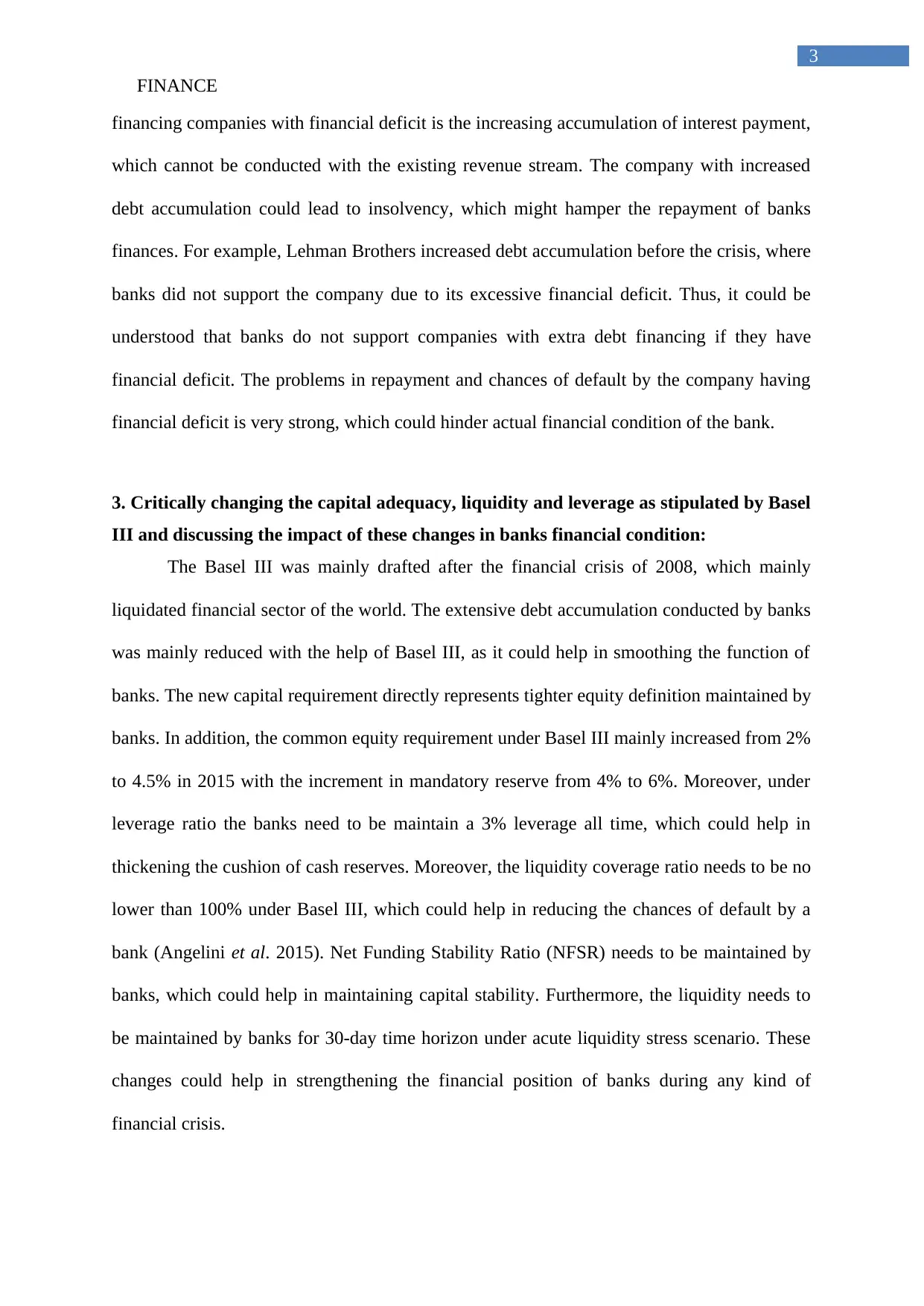
FINANCE
3
financing companies with financial deficit is the increasing accumulation of interest payment,
which cannot be conducted with the existing revenue stream. The company with increased
debt accumulation could lead to insolvency, which might hamper the repayment of banks
finances. For example, Lehman Brothers increased debt accumulation before the crisis, where
banks did not support the company due to its excessive financial deficit. Thus, it could be
understood that banks do not support companies with extra debt financing if they have
financial deficit. The problems in repayment and chances of default by the company having
financial deficit is very strong, which could hinder actual financial condition of the bank.
3. Critically changing the capital adequacy, liquidity and leverage as stipulated by Basel
III and discussing the impact of these changes in banks financial condition:
The Basel III was mainly drafted after the financial crisis of 2008, which mainly
liquidated financial sector of the world. The extensive debt accumulation conducted by banks
was mainly reduced with the help of Basel III, as it could help in smoothing the function of
banks. The new capital requirement directly represents tighter equity definition maintained by
banks. In addition, the common equity requirement under Basel III mainly increased from 2%
to 4.5% in 2015 with the increment in mandatory reserve from 4% to 6%. Moreover, under
leverage ratio the banks need to be maintain a 3% leverage all time, which could help in
thickening the cushion of cash reserves. Moreover, the liquidity coverage ratio needs to be no
lower than 100% under Basel III, which could help in reducing the chances of default by a
bank (Angelini et al. 2015). Net Funding Stability Ratio (NFSR) needs to be maintained by
banks, which could help in maintaining capital stability. Furthermore, the liquidity needs to
be maintained by banks for 30-day time horizon under acute liquidity stress scenario. These
changes could help in strengthening the financial position of banks during any kind of
financial crisis.
3
financing companies with financial deficit is the increasing accumulation of interest payment,
which cannot be conducted with the existing revenue stream. The company with increased
debt accumulation could lead to insolvency, which might hamper the repayment of banks
finances. For example, Lehman Brothers increased debt accumulation before the crisis, where
banks did not support the company due to its excessive financial deficit. Thus, it could be
understood that banks do not support companies with extra debt financing if they have
financial deficit. The problems in repayment and chances of default by the company having
financial deficit is very strong, which could hinder actual financial condition of the bank.
3. Critically changing the capital adequacy, liquidity and leverage as stipulated by Basel
III and discussing the impact of these changes in banks financial condition:
The Basel III was mainly drafted after the financial crisis of 2008, which mainly
liquidated financial sector of the world. The extensive debt accumulation conducted by banks
was mainly reduced with the help of Basel III, as it could help in smoothing the function of
banks. The new capital requirement directly represents tighter equity definition maintained by
banks. In addition, the common equity requirement under Basel III mainly increased from 2%
to 4.5% in 2015 with the increment in mandatory reserve from 4% to 6%. Moreover, under
leverage ratio the banks need to be maintain a 3% leverage all time, which could help in
thickening the cushion of cash reserves. Moreover, the liquidity coverage ratio needs to be no
lower than 100% under Basel III, which could help in reducing the chances of default by a
bank (Angelini et al. 2015). Net Funding Stability Ratio (NFSR) needs to be maintained by
banks, which could help in maintaining capital stability. Furthermore, the liquidity needs to
be maintained by banks for 30-day time horizon under acute liquidity stress scenario. These
changes could help in strengthening the financial position of banks during any kind of
financial crisis.
Paraphrase This Document
Need a fresh take? Get an instant paraphrase of this document with our AI Paraphraser
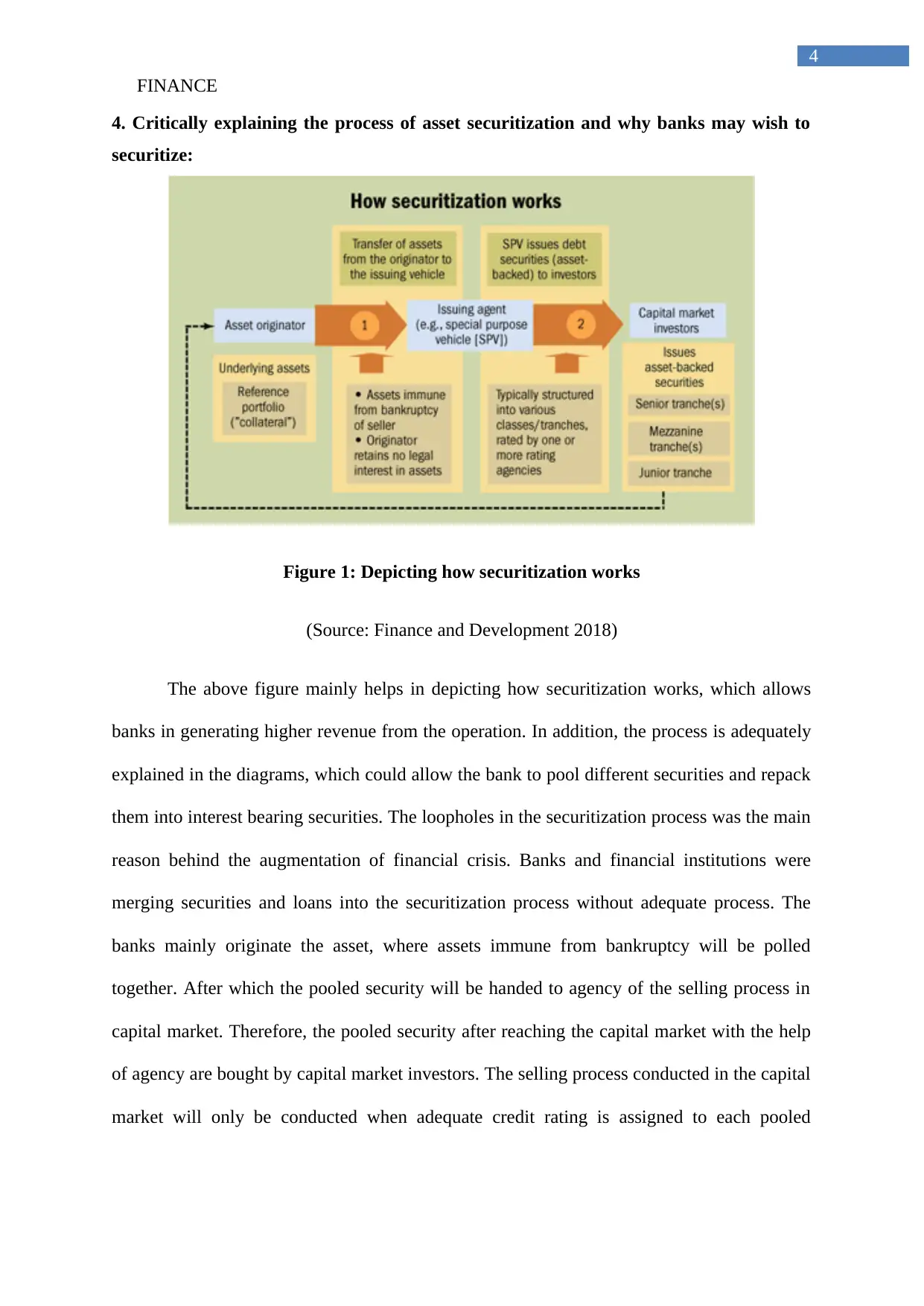
FINANCE
4
4. Critically explaining the process of asset securitization and why banks may wish to
securitize:
Figure 1: Depicting how securitization works
(Source: Finance and Development 2018)
The above figure mainly helps in depicting how securitization works, which allows
banks in generating higher revenue from the operation. In addition, the process is adequately
explained in the diagrams, which could allow the bank to pool different securities and repack
them into interest bearing securities. The loopholes in the securitization process was the main
reason behind the augmentation of financial crisis. Banks and financial institutions were
merging securities and loans into the securitization process without adequate process. The
banks mainly originate the asset, where assets immune from bankruptcy will be polled
together. After which the pooled security will be handed to agency of the selling process in
capital market. Therefore, the pooled security after reaching the capital market with the help
of agency are bought by capital market investors. The selling process conducted in the capital
market will only be conducted when adequate credit rating is assigned to each pooled
4
4. Critically explaining the process of asset securitization and why banks may wish to
securitize:
Figure 1: Depicting how securitization works
(Source: Finance and Development 2018)
The above figure mainly helps in depicting how securitization works, which allows
banks in generating higher revenue from the operation. In addition, the process is adequately
explained in the diagrams, which could allow the bank to pool different securities and repack
them into interest bearing securities. The loopholes in the securitization process was the main
reason behind the augmentation of financial crisis. Banks and financial institutions were
merging securities and loans into the securitization process without adequate process. The
banks mainly originate the asset, where assets immune from bankruptcy will be polled
together. After which the pooled security will be handed to agency of the selling process in
capital market. Therefore, the pooled security after reaching the capital market with the help
of agency are bought by capital market investors. The selling process conducted in the capital
market will only be conducted when adequate credit rating is assigned to each pooled
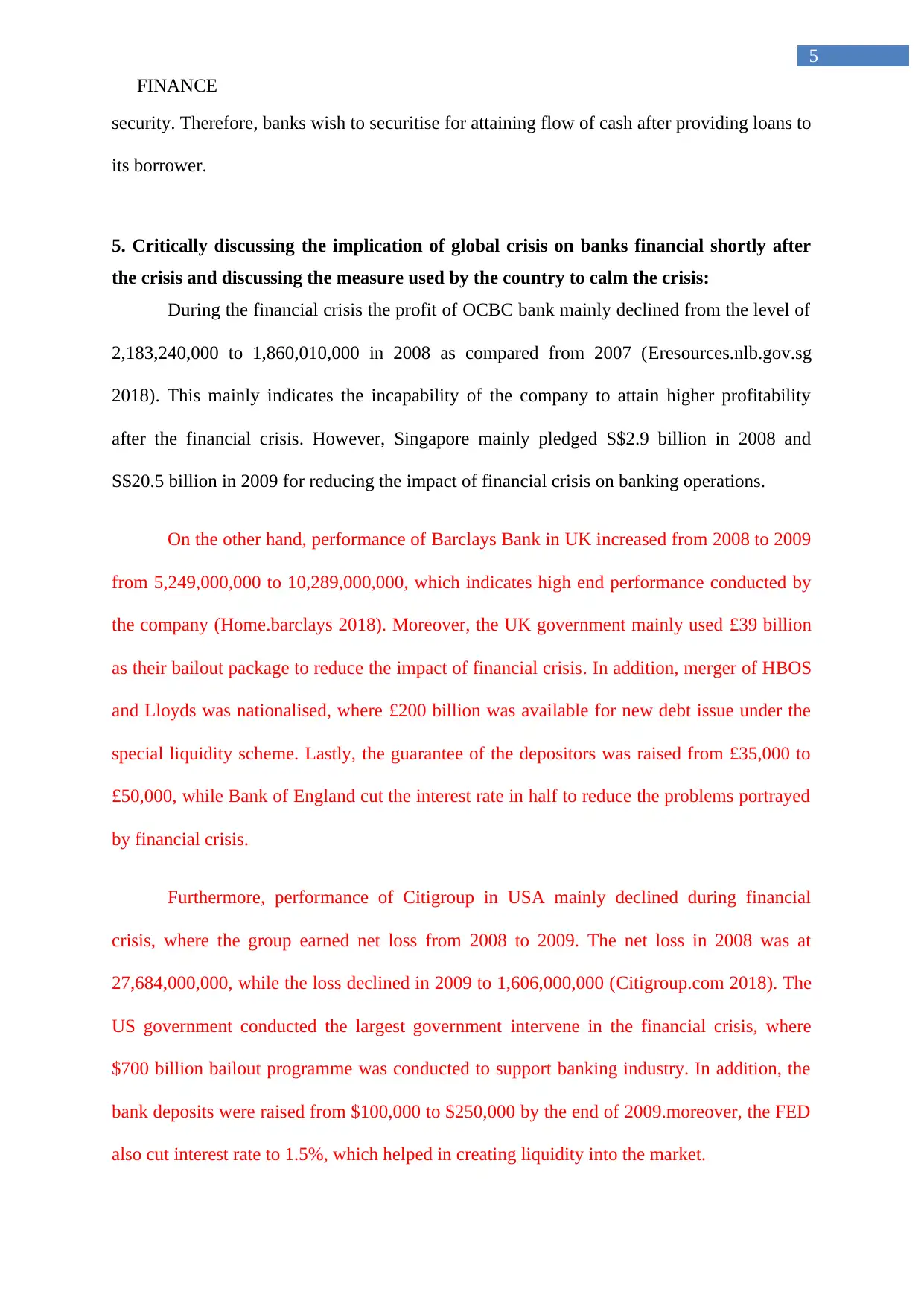
FINANCE
5
security. Therefore, banks wish to securitise for attaining flow of cash after providing loans to
its borrower.
5. Critically discussing the implication of global crisis on banks financial shortly after
the crisis and discussing the measure used by the country to calm the crisis:
During the financial crisis the profit of OCBC bank mainly declined from the level of
2,183,240,000 to 1,860,010,000 in 2008 as compared from 2007 (Eresources.nlb.gov.sg
2018). This mainly indicates the incapability of the company to attain higher profitability
after the financial crisis. However, Singapore mainly pledged S$2.9 billion in 2008 and
S$20.5 billion in 2009 for reducing the impact of financial crisis on banking operations.
On the other hand, performance of Barclays Bank in UK increased from 2008 to 2009
from 5,249,000,000 to 10,289,000,000, which indicates high end performance conducted by
the company (Home.barclays 2018). Moreover, the UK government mainly used £39 billion
as their bailout package to reduce the impact of financial crisis. In addition, merger of HBOS
and Lloyds was nationalised, where £200 billion was available for new debt issue under the
special liquidity scheme. Lastly, the guarantee of the depositors was raised from £35,000 to
£50,000, while Bank of England cut the interest rate in half to reduce the problems portrayed
by financial crisis.
Furthermore, performance of Citigroup in USA mainly declined during financial
crisis, where the group earned net loss from 2008 to 2009. The net loss in 2008 was at
27,684,000,000, while the loss declined in 2009 to 1,606,000,000 (Citigroup.com 2018). The
US government conducted the largest government intervene in the financial crisis, where
$700 billion bailout programme was conducted to support banking industry. In addition, the
bank deposits were raised from $100,000 to $250,000 by the end of 2009.moreover, the FED
also cut interest rate to 1.5%, which helped in creating liquidity into the market.
5
security. Therefore, banks wish to securitise for attaining flow of cash after providing loans to
its borrower.
5. Critically discussing the implication of global crisis on banks financial shortly after
the crisis and discussing the measure used by the country to calm the crisis:
During the financial crisis the profit of OCBC bank mainly declined from the level of
2,183,240,000 to 1,860,010,000 in 2008 as compared from 2007 (Eresources.nlb.gov.sg
2018). This mainly indicates the incapability of the company to attain higher profitability
after the financial crisis. However, Singapore mainly pledged S$2.9 billion in 2008 and
S$20.5 billion in 2009 for reducing the impact of financial crisis on banking operations.
On the other hand, performance of Barclays Bank in UK increased from 2008 to 2009
from 5,249,000,000 to 10,289,000,000, which indicates high end performance conducted by
the company (Home.barclays 2018). Moreover, the UK government mainly used £39 billion
as their bailout package to reduce the impact of financial crisis. In addition, merger of HBOS
and Lloyds was nationalised, where £200 billion was available for new debt issue under the
special liquidity scheme. Lastly, the guarantee of the depositors was raised from £35,000 to
£50,000, while Bank of England cut the interest rate in half to reduce the problems portrayed
by financial crisis.
Furthermore, performance of Citigroup in USA mainly declined during financial
crisis, where the group earned net loss from 2008 to 2009. The net loss in 2008 was at
27,684,000,000, while the loss declined in 2009 to 1,606,000,000 (Citigroup.com 2018). The
US government conducted the largest government intervene in the financial crisis, where
$700 billion bailout programme was conducted to support banking industry. In addition, the
bank deposits were raised from $100,000 to $250,000 by the end of 2009.moreover, the FED
also cut interest rate to 1.5%, which helped in creating liquidity into the market.
⊘ This is a preview!⊘
Do you want full access?
Subscribe today to unlock all pages.

Trusted by 1+ million students worldwide
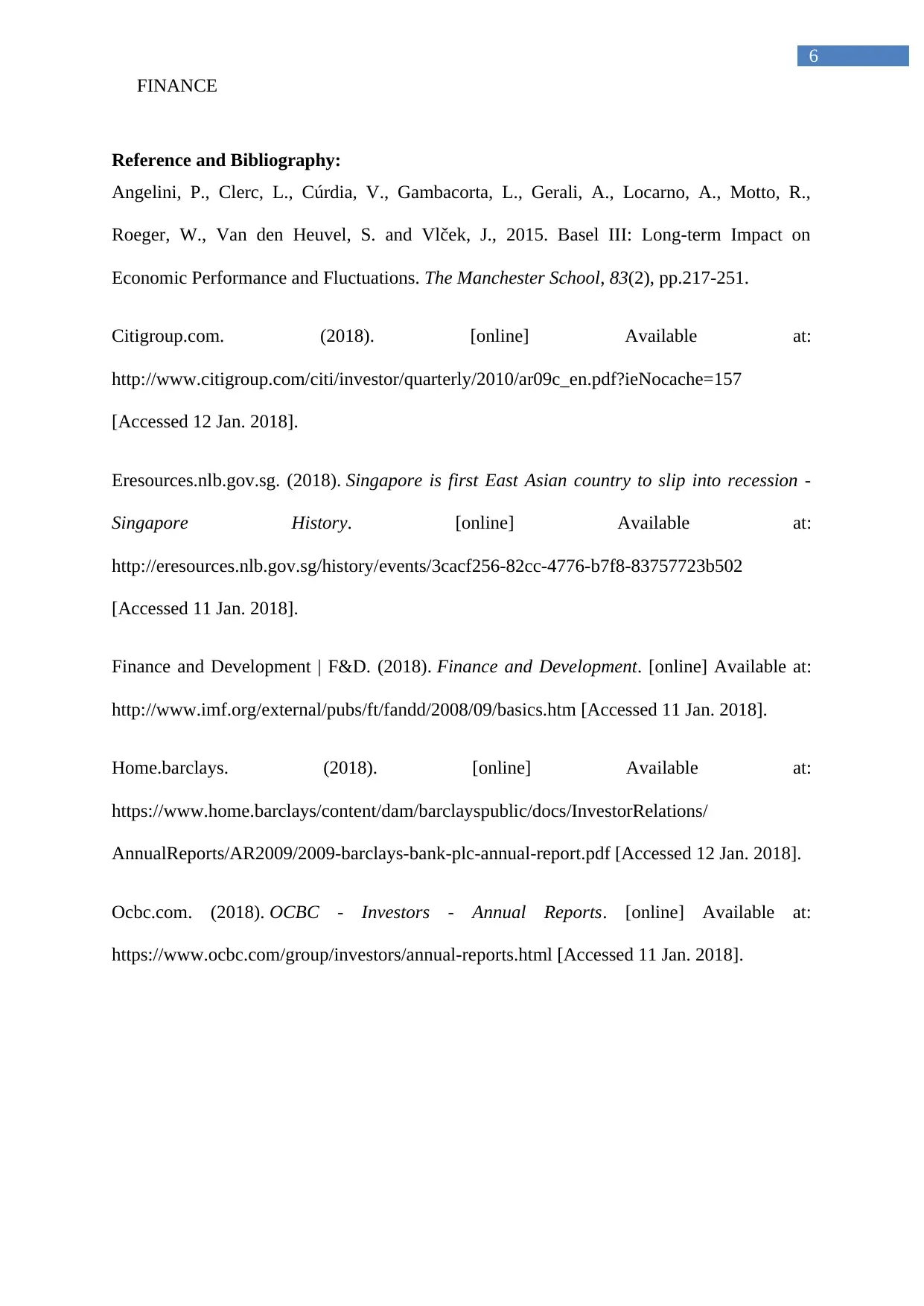
FINANCE
6
Reference and Bibliography:
Angelini, P., Clerc, L., Cúrdia, V., Gambacorta, L., Gerali, A., Locarno, A., Motto, R.,
Roeger, W., Van den Heuvel, S. and Vlček, J., 2015. Basel III: Long‐term Impact on
Economic Performance and Fluctuations. The Manchester School, 83(2), pp.217-251.
Citigroup.com. (2018). [online] Available at:
http://www.citigroup.com/citi/investor/quarterly/2010/ar09c_en.pdf?ieNocache=157
[Accessed 12 Jan. 2018].
Eresources.nlb.gov.sg. (2018). Singapore is first East Asian country to slip into recession -
Singapore History. [online] Available at:
http://eresources.nlb.gov.sg/history/events/3cacf256-82cc-4776-b7f8-83757723b502
[Accessed 11 Jan. 2018].
Finance and Development | F&D. (2018). Finance and Development. [online] Available at:
http://www.imf.org/external/pubs/ft/fandd/2008/09/basics.htm [Accessed 11 Jan. 2018].
Home.barclays. (2018). [online] Available at:
https://www.home.barclays/content/dam/barclayspublic/docs/InvestorRelations/
AnnualReports/AR2009/2009-barclays-bank-plc-annual-report.pdf [Accessed 12 Jan. 2018].
Ocbc.com. (2018). OCBC - Investors - Annual Reports. [online] Available at:
https://www.ocbc.com/group/investors/annual-reports.html [Accessed 11 Jan. 2018].
6
Reference and Bibliography:
Angelini, P., Clerc, L., Cúrdia, V., Gambacorta, L., Gerali, A., Locarno, A., Motto, R.,
Roeger, W., Van den Heuvel, S. and Vlček, J., 2015. Basel III: Long‐term Impact on
Economic Performance and Fluctuations. The Manchester School, 83(2), pp.217-251.
Citigroup.com. (2018). [online] Available at:
http://www.citigroup.com/citi/investor/quarterly/2010/ar09c_en.pdf?ieNocache=157
[Accessed 12 Jan. 2018].
Eresources.nlb.gov.sg. (2018). Singapore is first East Asian country to slip into recession -
Singapore History. [online] Available at:
http://eresources.nlb.gov.sg/history/events/3cacf256-82cc-4776-b7f8-83757723b502
[Accessed 11 Jan. 2018].
Finance and Development | F&D. (2018). Finance and Development. [online] Available at:
http://www.imf.org/external/pubs/ft/fandd/2008/09/basics.htm [Accessed 11 Jan. 2018].
Home.barclays. (2018). [online] Available at:
https://www.home.barclays/content/dam/barclayspublic/docs/InvestorRelations/
AnnualReports/AR2009/2009-barclays-bank-plc-annual-report.pdf [Accessed 12 Jan. 2018].
Ocbc.com. (2018). OCBC - Investors - Annual Reports. [online] Available at:
https://www.ocbc.com/group/investors/annual-reports.html [Accessed 11 Jan. 2018].
1 out of 7
Your All-in-One AI-Powered Toolkit for Academic Success.
+13062052269
info@desklib.com
Available 24*7 on WhatsApp / Email
![[object Object]](/_next/static/media/star-bottom.7253800d.svg)
Unlock your academic potential
Copyright © 2020–2025 A2Z Services. All Rights Reserved. Developed and managed by ZUCOL.


